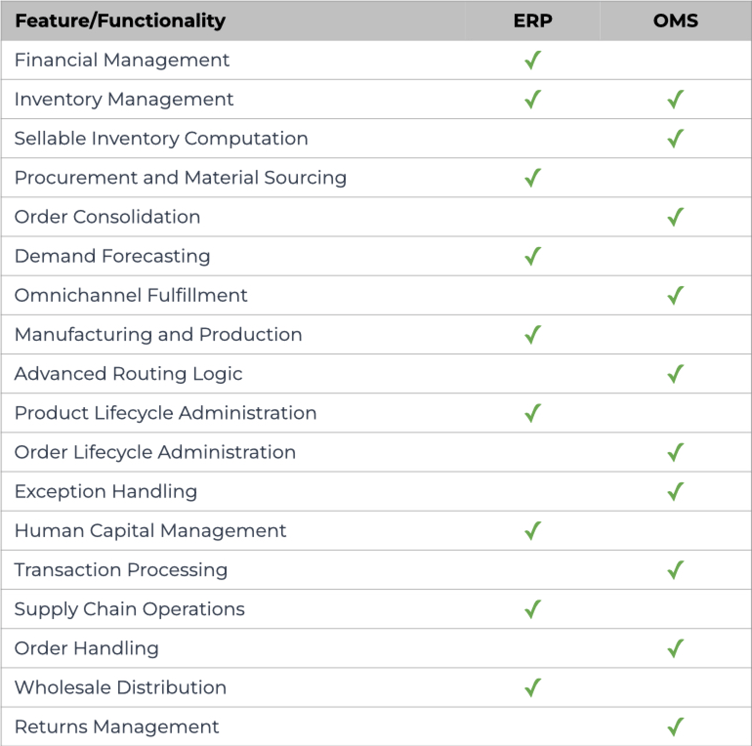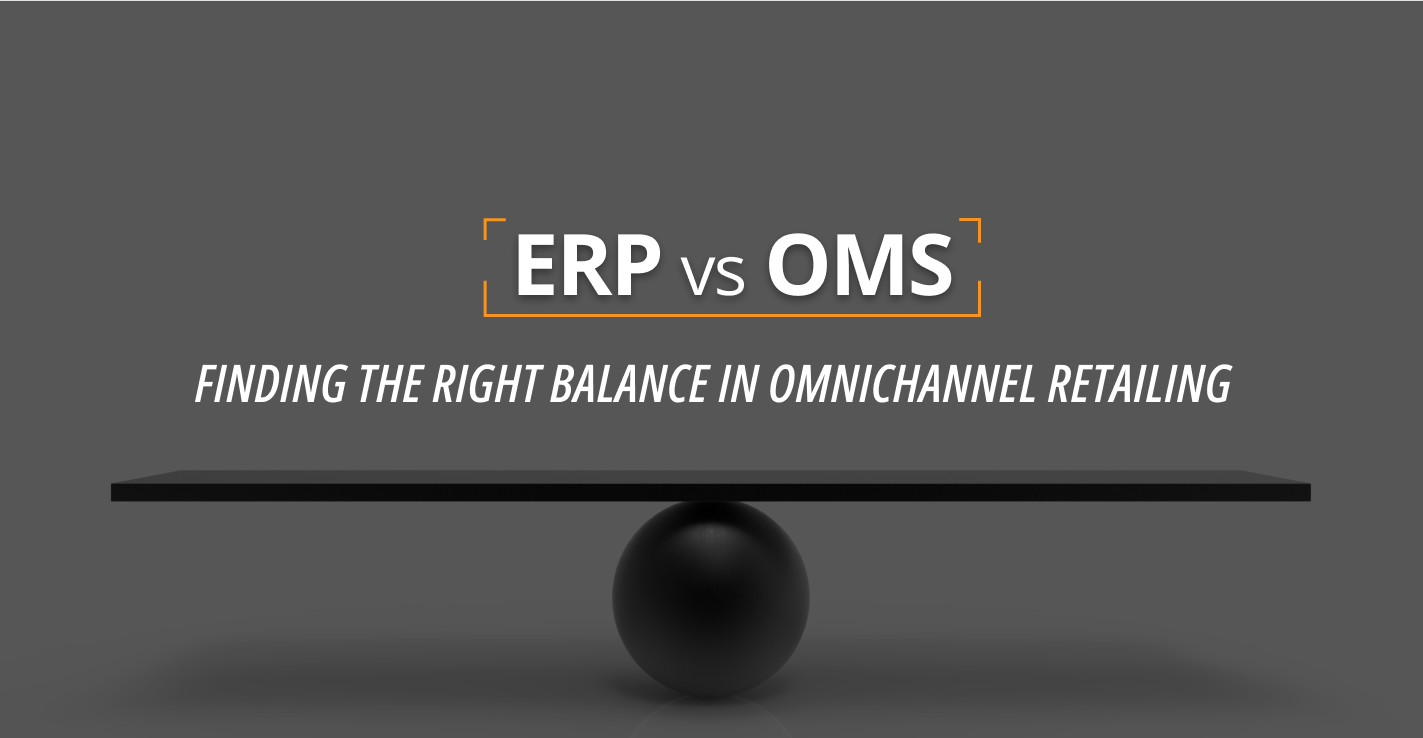In the ever-evolving landscape of retail, staying ahead of the curve is paramount. Two indispensable tools in this transformation are Enterprise Resource Planning (ERP) systems and Omnichannel Order Management Systems (OMS). However, a common misconception prevails among retailers: the belief that a robust ERP system is all it takes to manage omnichannel operations. This notion can falter significantly in the world of omnichannel retailing, where real-time inventory management, seamless order processing, the integration of diverse sales channels, and other critical functionalities are crucial.
History of ERP and Its Origins
ERP systems originated as solutions for manufacturing organizations, initially streamlining processes and enhancing efficiency. Over time, they expanded their reach, becoming synonymous with accounting software in many businesses. ERP systems became a go-to solution for managing various functions, from sales and distribution to manufacturing processes, procurement to payment workflows, and accounting. These comprehensive systems became the backbone of companies, aiding them in optimizing operations and gaining better control over their processes.
As the retail industry evolved, ERP systems transcended sectors and became instrumental in streamlining operations and managing financial aspects efficiently. ERP systems gained prominence for handling everything from order processing and inventory management to financial reporting and human resources. They also excelled in managing sales and distribution processes, further solidifying their role in businesses of all kinds.
Emergence of eCommerce and the Rise of Omnichannel Retailing
The advent of e-commerce marked a turning point in retail history, reshaping the way people shop. With the internet and digital technologies, shopping transcended physical store boundaries, enabling customers to browse, select, and purchase products from the comfort of their homes.
As eCommerce continued to grow, it evolved beyond online storefronts. Omnichannel retailing emerged as a strategy that seamlessly integrates various sales channels, providing customers with a cohesive and consistent shopping experience. This strategy extends beyond eCommerce, encompassing brick-and-mortar stores, mobile apps, and other touchpoints.
One of the core principles of omnichannel retailing is "Buy Online, Pick Up In Store" (BOPIS), allowing customers to make online purchases and collect them from physical stores. Another facet is "Ship from Store," where retailers use physical store locations as distribution centers, fulfilling online orders directly from these stores. These strategies not only reduce shipping times but also optimize inventory management.
In essence, omnichannel retailing aims to create a seamless shopping journey, allowing customers to transition effortlessly between online and offline channels. It recognizes that consumers often engage with a brand through multiple touchpoints before making a purchase. Therefore, an omnichannel approach ensures that these touchpoints work cohesively, providing a unified brand experience.
Limitations of ERP in Omnichannel Retailing
1. Calculating Real-time Inventory Availability
Accurate and real-time inventory availability is a critical aspect of omnichannel retailing. Here's a deeper exploration of this limitation:
While ERP systems are proficient in managing physical inventory within an organization's various storage locations, they often struggle when it comes to calculating Available-to-Promise (ATP) inventory in real-time. ATP inventory considers various factors, such as safety stock levels, order thresholds, and the availability of fulfillment centers, including those that may be temporarily unavailable.
In the context of omnichannel retailing, it's essential to provide customers with up-to-the-minute information about product stock levels. This information not only prevents overselling and underselling but also enhances the overall customer experience.
Traditional ERP systems, designed primarily for batch processing and not optimized for dynamic inventory calculations, may not possess the agility or sophistication required to calculate ATP inventory in real time. This limitation can result in inventory inaccuracies, potentially leading to customer dissatisfaction and lost sales.
2. Real-time Order Management
In the era of omnichannel retailing, customers have come to expect real-time order processing and updates. Here's a more detailed perspective on this limitation:
Traditional ERP systems were often optimized for batch processing, which means that they process transactions in predefined groups or batches. This approach worked well for industries where immediate transaction processing was not critical, such as manufacturing or finance. However, in the fast-paced world of retail, particularly in eCommerce, real-time order management is essential.
Customers expect instant order confirmations, real-time updates on their order status, and immediate adjustments to inventory levels. ERP systems optimized for batch processing may struggle to provide these real-time capabilities. This can result in customers receiving delayed or inaccurate information about their orders, leading to frustration and potential loss of business.
In omnichannel retailing, where orders can originate from various channels and need to be fulfilled quickly and accurately, real-time order management is a fundamental requirement. Traditional ERP systems may fall short in meeting these expectations.
3. Scaling for B2C Order Volumes
Scalability is a critical consideration in the limitations of ERP, particularly when it comes to omnichannel retailing. Here's a more in-depth perspective:
ERPs were originally developed with a focus on B2B (business-to-business) use cases, where daily order volumes and transactional data were relatively low compared to the scale of eCommerce operations. In the world of omnichannel retailing, especially for businesses experiencing rapid growth, the number of daily orders can increase exponentially.
This scalability challenge manifests when trying to maintain real-time integration between eCommerce platforms and the ERP system. As the order volume surges, the ERP may struggle to process and synchronize orders in real time. This can result in delayed order confirmations, inventory inaccuracies, and ultimately, a subpar customer experience.
To accommodate the demands of omnichannel retailing, businesses need systems that can seamlessly scale with their operations, providing the agility to handle fluctuating order volumes, especially during peak seasons.
4. Integration Challenges with Modern Systems
Traditional ERP systems, particularly those designed for on-premise use, often face difficulties when it comes to integrating with modern, cloud-based systems and services.
Modern retail relies heavily on a diverse set of systems, from eCommerce platforms to customer relationship management (CRM) software and logistics solutions. These systems need to seamlessly communicate and share data to provide a unified customer experience. However, many legacy ERP systems were not built with the agility or compatibility needed for this level of integration.
As a result, retailers may encounter difficulties when attempting to synchronize data between their ERP systems and newer, cloud-based applications. This can lead to delays in data updates, potential data inconsistencies, and an overall disjointed view of the business, which is far from ideal in the fast-paced world of omnichannel retailing.
The Role of Omnichannel Order Management Systems
1. Real-time Inventory Visibility with ATP Calculations
OMS systems provide retailers with real-time inventory visibility by seamlessly integrating with Warehouse Management Systems (WMS), Enterprise Resource Planning (ERP) systems, Point of Sale (POS) systems, and other sources. This integration allows OMS to access near real-time inventory data.
A pivotal function of OMS is the calculation and presentation of Available-to-Promise (ATP) inventory information to customers. ATP calculations consider factors such as safety stock levels, order thresholds, and the availability of diverse fulfillment centers
For instance, OMS continuously monitors real-time inventory levels, accounting for safety stock to handle demand surges, order thresholds triggering automatic replenishments, and the accessibility of fulfillment centers. This ongoing calculation yields a precise ATP inventory figure, indicating the number of units available for immediate selling.
2. Inventory Synchronization to eCommerce Platforms
In addition to ATP calculations, OMS systems play an important role in inventory synchronization to eCommerce platforms. This ensures that customers browsing online stores always see accurate and up-to-the-minute inventory availability for each product.
Once the OMS determines ATP inventory, it synchronizes this information with the eCommerce platform's inventory data in near real-time. This synchronization guarantees that customers never place orders for products no longer in stock, providing an impeccable shopping experience.
3. Order Routing and Processing
OMS goes beyond inventory management; it excels in order routing and processing. When a customer places an order, OMS determines the optimal fulfillment strategy. This decision takes into account factors like the customer's location, the location of available inventory, and various fulfillment options, such as shipping from a warehouse or picking up from a nearby store.
The ability to efficiently route orders ensures that customers receive their purchases quickly and cost-effectively. For example, if a customer is near a physical store with the requested item in stock, OMS may route the order for in-store pickup, saving time and shipping costs.
4. Middleware for Legacy Systems
OMS plays a pivotal role in bridging the gap between modern eCommerce applications and legacy systems, such as ERP. It utilizes a multifaceted approach to ensure smooth data exchange between these diverse components, enabling a harmonious operation within the omnichannel retail ecosystem.
On one hand, OMS leverages modern technologies like RestAPI and GraphQL to seamlessly connect with modern eCommerce platforms. This approach facilitates real-time data exchange, ensuring that information flows freely between the OMS and contemporary eCommerce applications. Such integration empowers retailers to offer customers a dynamic and responsive shopping experience, with up-to-the-minute data on inventory availability, order status, and more.
On the other hand, OMS collaborates effectively with ERP systems, recognizing that some legacy systems may not readily support real-time integration. In such cases, OMS employs traditional methods like batch processing using CSV (Comma-Separated Values) files and SFTP (Secure File Transfer Protocol) to exchange data. These batch processes ensure that critical information, including orders and customer data, flows smoothly between ERP-OMS, maintaining data integrity and consistency.
By serving as a versatile middleware layer, OMS empowers retailers to embrace modern eCommerce capabilities while harmoniously coexisting with legacy systems. This flexibility ensures that businesses can optimize their existing technology investments and adapt to the evolving demands of omnichannel retailing.
Bridging the Gap for Omnichannel Success
In the ever-evolving landscape of retail, both ERP-OMS play vital roles. However, they serve different purposes and excel in distinct areas. ERP systems are the backbone for managing procurement to payment workflows, accounting, and broader operational functions. On the other hand, Omnichannel OMS is the linchpin for omnichannel retailing, facilitating inventory availability for eCommerce, order routing, processing, and fulfillment.

Fig.1: ERP vs OMS in Omnichannel Retailing
To thrive in today's omnichannel retail environment, businesses need to recognize the unique strengths of each system and harness them harmoniously. It's not a matter of ERP vs. OMS but rather a matter of ERP-OMS working together to provide a seamless and efficient retail experience, from the back-end operations to the customer's shopping cart. In this synergy lies the future success of omnichannel retailers. By addressing the limitations of ERP and leveraging the capabilities of OMS, retailers can meet the demands of modern consumers and deliver exceptional shopping experiences across all channels.
* * *
If you're eager to explore the dynamic possibilities of ERP-OMS working together to elevate your retail business,Contact us now for a consultation tailored to your needs and let's bridge the gaps for omnichannel success!









